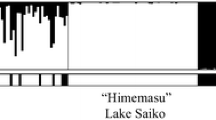Abstract
The three cladoceran speciesDaphnia hyalina, D. galeata, andD. cucullata frequently coexist in the lakes of northern Germany. Although there are some problems in distinguishing them morphologically, they are easily determined by gelelectrophoresis: each species carries a different allele at the glutamate oxaloacetate transaminase (GOT) locus. Animals morphologically intermediate between two species are heterozygous for the alleles carried by the species they resemble. This pattern is in agreement with the findings at other loci, where also diagnostic alleles exist. These findings are most easily explained by interspecific hybridization between the three species. No evidence is found for backcrosses involving hybrids ofD. cucullata, whereas some backcrosses betweenD. hyalina, D. galeata, and their hybrids are found in some lakes. In four lakes the seasonal abundances of the three species and their hybrids are determined.
Similar content being viewed by others
References
Brooks, J. L., 1957a. The systematics of North AmericanDaphnia. Mem. Conn. Acad. Arts Sci. 13: 5–180.
Brooks, J. L., 1957b. The species problem in freshwater animals. In: E. Mayr (ed), The species problem. Am. Ass. Advmt. Sci., Washington: 81–123.
Einsle, U., 1966. Einige Beobachtungen und Hypothesen zur Taxonomie der GattungDaphnia. Schriften des Vereins für Geschichte des Bodensees und seiner Umgebung 84: 1–17.
Einsle, U., 1983. Die Entwicklung und Männchenbildung derDaphnia-Population im Bodensee-Obersee 1956–1980. Schweiz. Z. Hydrol. 45: 321–332.
Flössner, D., 1972. Kiemen- und Blattfüsser, Branchiopoda. Fischläuse, Branchiura. Tierwelt Dtl. 60: 501 pp.
Hebert, P. D. N., 1978. The population biology ofDaphnia (Crustacea, Daphniidae). Biol. Rev. 53: 387–426.
Hebert, P. D. N., 1985. Interspecific hybridization between cyclic parthenogens. Evolution 39: 216–220.
Hutchinson, G. E., 1967. A treatise on limnology, 2. J. Wiley & Sons, New York, 1115 pp.
Lieder, U., 1983. Introgression as a factor in the evolution of polytypical plankton Cladocera. Int. Revue ges. Hydrobiol. 68: 269–284.
Wolf, H. G., 1982. A comparison of different electrophoretic techniques for the detection of isozymes in single daphniids. Arch. Hydrobiol. 95: 521–531.
Wolf, H. G. & M. A. Mort, 1986. Interspecific hybridization underlies phenotypic variability inDaphnia populations. Oecologia (Berlin) 68: 507–511.
Author information
Authors and Affiliations
Rights and permissions
About this article
Cite this article
Wolf, H.G. Interspecific hybridization betweenDaphnia hyalina, D. galeata, andD. cucullata and seasonal abundances of these species and their hybrids. Hydrobiologia 145, 213–217 (1987). https://doi.org/10.1007/BF02530282
Issue Date:
DOI: https://doi.org/10.1007/BF02530282




